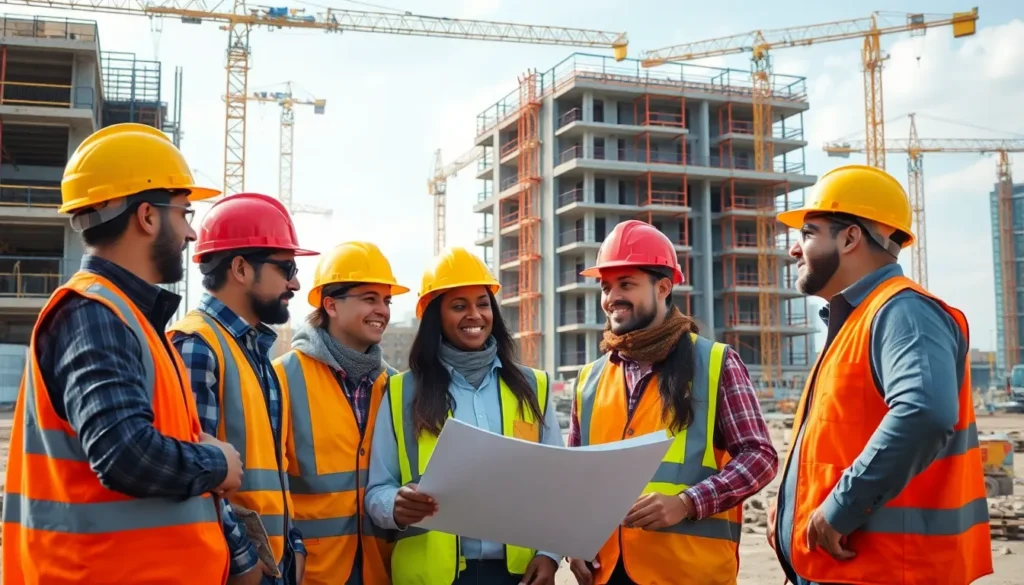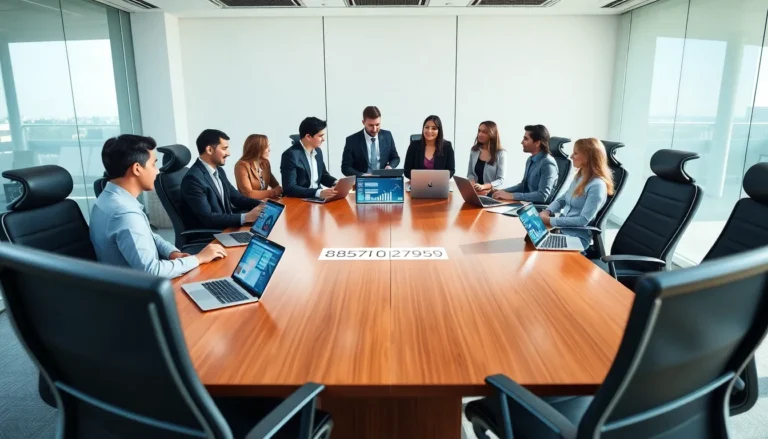Table of Contents
ToggleIn the bustling world of commercial building construction, where dreams take shape and concrete becomes a canvas, there’s more than meets the eye. It’s not just about bricks and mortar; it’s about creating spaces that foster innovation, collaboration, and maybe even the occasional office coffee break that turns into a brainstorming session. Who knew that a well-placed window could inspire such creativity?
Overview of Commercial Building Construction
Commercial building construction encompasses various aspects beyond merely assembling structures. The process involves careful planning and execution, focusing on design elements that promote functionality and creativity. Architects and designers play a crucial role in shaping these environments to meet the unique needs of businesses and their employees.
In commercial settings, projects may include office buildings, retail spaces, and warehouses. Each type demands specific considerations during construction. For instance, office buildings require layouts that facilitate collaboration, while retail spaces focus on customer experience and accessibility.
Construction methods vary depending on the project’s size, budget, and timeline. Traditional methods like masonry and concrete are often paired with modern techniques such as prefabrication. These approaches can significantly reduce construction time while maintaining structural integrity.
Incorporating sustainable practices is increasingly important in commercial construction. Green building standards, such as LEED (Leadership in Energy and Environmental Design), guide developers toward creating environmentally friendly structures. These buildings often feature energy-efficient systems, sustainable materials, and methods that minimize environmental impact.
Safety remains a top priority on construction sites, necessitating strict adherence to regulations and best practices. Workers receive training to handle tools and equipment safely, ensuring a secure environment during the building process.
Stakeholder engagement is essential throughout the construction phase. Regular communication between architects, builders, and clients fosters collaboration, allowing for adjustments based on feedback. This collaborative approach enhances the final outcome and ensures that the project meets its intended goals.
Key Components of Commercial Building Construction

Commercial building construction encompasses several critical components that ensure successful project execution. Focusing on site selection, design, materials, and resources contributes to creating functional and sustainable spaces tailored to business needs.
Site Selection and Preparation
Site selection plays a crucial role in commercial construction. Factors such as location, accessibility, zoning regulations, and environmental assessments significantly influence the decision-making process. Thorough site preparation is necessary, involving clearing, grading, and excavation. Assessing soil stability and drainage requirements further ensures the foundational integrity of the structure. Effective site preparation sets the stage for a successful construction phase.
Building Design and Architecture
Building design and architecture encompass more than aesthetics; they prioritize functionality and adaptability. Architects collaborate with clients to identify specific needs, considering aspects like space utilization and flow. Integrating modern technology and sustainable practices enhances efficiency and performance. A well-designed building reflects the brand while fostering an environment that encourages innovation and productivity. Design flexibility allows adaptation to future business needs.
Materials and Resources
Material selection impacts the overall quality and sustainability of the construction project. Using durable and environmentally friendly materials supports green building practices, aligning with certifications like LEED. Common materials used in commercial building construction include steel, concrete, and glass, each offering distinct advantages. Effective resource management ensures timely procurement and minimizes waste. Collaborating with suppliers can lead to innovative solutions and optimized costs throughout the construction process.
Construction Process and Management
The construction process involves strategic planning and execution to ensure successful project outcomes.
Project Planning and Scheduling
Effective project planning sets the foundation for commercial construction. It begins with defining project scope and timelines. Stakeholders establish clear objectives to guide every phase. Conducting site analysis and feasibility studies informs decision-making early on. Utilizing project management software enhances scheduling efficiency. Teams implement Gantt charts to visualize timelines and track progress. Regular milestone reviews help maintain alignment with goals. Adapting schedules to unforeseen challenges is essential for keeping projects on track.
Budgeting and Cost Control
Budgeting plays a critical role in managing commercial construction projects. It starts with a detailed cost estimate, encompassing labor, materials, and permits. Stakeholders continually monitor expenses to prevent budget overruns. Implementing tracking tools allows for real-time financial oversight. Contractors negotiate contracts to secure competitive pricing without compromising quality. Conducting regular budget reviews enables timely adjustments. Managing cash flow ensures that funds remain available throughout the project lifecycle. Prioritizing cost control fosters financial accountability and supports overall project success.
Challenges in Commercial Building Construction
Commercial building construction faces several challenges that require careful management and strategic solutions.
Regulatory and Compliance Issues
Regulatory hurdles and compliance requirements pose significant challenges in commercial construction. Building codes and zoning laws vary by location, impacting design options and project timelines. Engaging in proactive communication with local government agencies streamlines the permitting process. Contractors must stay updated on safety regulations, which ensure worker safety during construction. Navigating these complexities demands detailed knowledge to prevent costly delays and modifications down the line.
Environmental Considerations
Environmental factors play a critical role in commercial construction. Implementing sustainable practices not only meets regulatory standards but also reduces long-term operational costs. Green building materials and techniques, such as energy-efficient systems and renewable resources, enhance environmental performance. Assessing the environmental impact before project initiation helps identify potential challenges. Furthermore, integrating sustainable design promotes energy efficiency and attracts environmentally conscious tenants.
Innovations in Commercial Building Construction
Innovative technologies drive efficiency and sustainability in commercial building construction. Building Information Modeling (BIM) enhances collaboration among architects, engineers, and contractors. This digital representation of physical and functional characteristics improves design accuracy and project coordination.
3D printing serves as another breakthrough, allowing for rapid prototyping and customized building components. Companies can create intricate structures with reduced material waste. Robots are emerging on construction sites, performing tasks like bricklaying and welding, which increases precision and safety.
Smart building technologies integrate IoT (Internet of Things) devices into construction. These systems monitor energy use and optimize HVAC (heating, ventilation, air conditioning) systems for better efficiency. Sensors also provide real-time data on building performance, helping businesses reduce operational costs.
Modular construction simplifies the building process. Prefabricated modules allow for assembly on-site, minimizing construction time and disruption. Projects can be completed faster, leading to quicker occupancy and return on investment.
Sustainability practices continue to evolve with innovative materials. Biodegradable composites reduce environmental impact while maintaining structural integrity. Solar panels and green roofs enhance energy efficiency and provide long-term savings for tenants.
Advanced project management tools improve scheduling and budgeting. Cloud-based platforms facilitate real-time updates and enable stakeholders to track progress. These tools support proactive decision-making, ensuring projects remain aligned with their objectives.
Cultural shifts in the workplace lead to the demand for flexible spaces. Collaborative areas and adaptable layouts encourage innovation among employees. Designers are focusing on environments that foster creativity and improve employee satisfaction.
Commercial building construction is a dynamic field that demands a blend of creativity and practicality. The focus on innovative design and sustainable practices is reshaping how spaces are built and utilized. As businesses evolve the need for adaptable environments becomes increasingly important.
Stakeholder collaboration plays a pivotal role in achieving successful outcomes while navigating challenges like regulatory compliance and budget management. Embracing technology and modern construction methods enhances efficiency and fosters a culture of safety and sustainability.
Ultimately the future of commercial building construction lies in its ability to create spaces that inspire and support the diverse needs of businesses and their employees.








